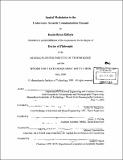| dc.contributor.advisor | Arthur B. Baggeroer and James C. Preisig. | en_US |
| dc.contributor.author | Kilfoyle, Daniel B. (Daniel Brian) | en_US |
| dc.contributor.other | Joint Program in Oceanography and Oceanographic Engineering. | en_US |
| dc.date.accessioned | 2005-09-27T20:16:59Z | |
| dc.date.available | 2005-09-27T20:16:59Z | |
| dc.date.copyright | 2000 | en_US |
| dc.date.issued | 2000 | en_US |
| dc.identifier.uri | http://hdl.handle.net/1721.1/29046 | |
| dc.description | Thesis (Ph. D.)--Joint Program in Oceanography and Oceanographic Engineering (Massachusetts Institute of Technology, Dept. of Electrical Engineering and Computer Science; and the Woods Hole Oceanographic Institution), 2000. | en_US |
| dc.description | Vita. | en_US |
| dc.description | Includes bibliographical references (leaves 180-181). | en_US |
| dc.description.abstract | A modulation technique for increasing the reliable data rate achievable by an underwater acoustic communication system is presented and demonstrated. The technique, termed spatial modulation, seeks to control the spatial distribution of signal energy such that multiple parallel communication channels are supported by the single, physical ocean channel. Results from several experiments successfully demonstrate higher obtainable data rates and power throughput. Given a signal energy constraint, a communication architecture with access to parallel channels will have increased capacity and reliability as compared to one with access to a single channel. Assuming the use of multiple element spatial arrays at both the transmitter and receiver, an analytic framework is developed that allows a multiple input, multiple output physical channel to be transformed into a set of virtual parallel channels. The continuous time, vector singular value decomposition is the primary vehicle for this transformation. Given knowledge of the channel impulse responses and assuming additive, white Gaussian noise as the only interference, the advantages of using spatial modulation over a deterministic channel may be exactly computed. Improving performance over an ensemble of channels using spatial modulation is approached by defining and then optimizing various average performance metrics including average signal to noise ratio, average signal to noise plus interference ratio, and minimum square error. Several field experiments were conducted. Detailed channel impulse response measurements were made enabling application of the decomposition methodology. The number, strength, and stability of the available parallel channels were analyzed. The parallel channels were readily interpreted in terms of the underlying sound propagation field. Acoustic communication tests were conducted comparing conventional coherent modulation to spatial modulation. In one case, a reliable data rate of 24000 bits per second with a 4 kHz bandwidth signal was achieved with spatial modulation when conventional signaling could not achieve that rate. In another test, the benefits of spatial modulation for a horizontally distributed communication system, such as an underwater network with autonomous underwater vehicles, were validated. | en_US |
| dc.description.statementofresponsibility | by Daniel Brian Kilfoyle. | en_US |
| dc.format.extent | 181 leaves | en_US |
| dc.format.extent | 13387731 bytes | |
| dc.format.extent | 13387490 bytes | |
| dc.format.mimetype | application/pdf | |
| dc.format.mimetype | application/pdf | |
| dc.language.iso | eng | en_US |
| dc.publisher | Massachusetts Institute of Technology | en_US |
| dc.rights | M.I.T. theses are protected by copyright. They may be viewed from this source for any purpose, but reproduction or distribution in any format is prohibited without written permission. See provided URL for inquiries about permission. | en_US |
| dc.rights.uri | http://dspace.mit.edu/handle/1721.1/7582 | |
| dc.subject | Electrical Engineering and Computer Science. | en_US |
| dc.subject | Joint Program in Oceanography and Oceanographic Engineering. | en_US |
| dc.subject | Woods Hole Oceanographic Institution. | en_US |
| dc.title | Spatial modulation in the underwater acoustic communication channel | en_US |
| dc.title.alternative | Spatial modulation in the UACC | en_US |
| dc.type | Thesis | en_US |
| dc.description.degree | Ph.D. | en_US |
| dc.contributor.department | Joint Program in Oceanography and Oceanographic Engineering | en_US |
| dc.contributor.department | Woods Hole Oceanographic Institution | en_US |
| dc.contributor.department | Massachusetts Institute of Technology. Department of Electrical Engineering and Computer Science | |
| dc.contributor.department | Massachusetts Institute of Technology. Department of Ocean Engineering | |
| dc.identifier.oclc | 46803092 | en_US |
